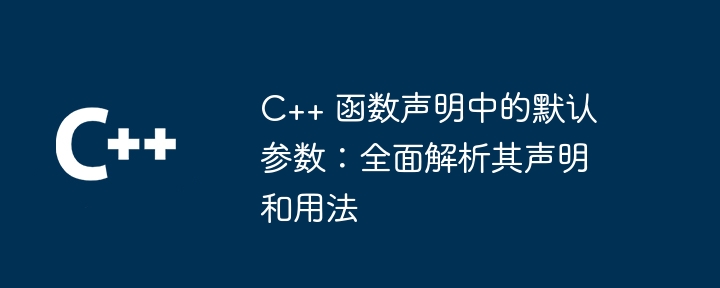 Backend Development
Backend Development
 C++
C++
 Default parameters in C++ function declarations: a comprehensive analysis of their declaration and usage
Default parameters in C++ function declarations: a comprehensive analysis of their declaration and usage
Default parameters in C++ function declarations: a comprehensive analysis of their declaration and usage
C++ 中的默认参数提供对函数参数指定默认值的功能,从而增强代码可读性、简洁性和灵活性。声明默认参数:在函数声明中将参数后加上 "=" 符号,后跟默认值。用法:函数调用时,若未提供可选参数,则会使用默认值。实战案例:计算两个数之和的函数,一个参数必填,另一个可填并有默认值 0。优点:增强可读性、增加灵活性、减少样板代码。注意事项:只能在声明中指定,必须位于末尾,类型必须兼容。

C++ 函数声明中的默认参数:全面解析其声明和用法
简介
默认参数是一种强大的 C++ 语言特性,它允许我们在函数声明中为函数参数指定默认值。此功能可以提高代码的可读性、简洁性和灵活性。本文将全面解析默认参数的声明和用法,并通过实战案例来演示其应用。
声明
以下是如何为函数参数定义默认参数:
void function(int x, int y = 0);
在这个声明中,x 是必需的参数,而 y 是具有默认值 0 的可选参数。如果函数调用时未提供 y 的值,则会使用默认值。
用法
要在函数调用中使用默认参数,我们只需传入必需的参数,即可:
function(5); // y 将使用默认值 0
但是,如果我们想覆盖默认值,我们可以显式地传入参数值:
function(5, 10); // y 将设置为 10
实战案例
让我们考虑一个计算两个数之和的函数:
int sum(int a, int b = 0) {
return a + b;
}在这个函数中,a 是必需的参数,而 b 是可选参数,默认为 0。此函数可以如下使用:
int result1 = sum(5); // b 默认为 0,因此 result1 为 5 int result2 = sum(5, 10); // b 被显式设置为 10,因此 result2 为 15
优点
使用默认参数有几个优点:
- 提高可读性:通过明确指定参数的默认值,我们可以使函数声明更加清晰和易于理解。
- 增加灵活性:默认参数允许我们创建可处理多种输入情况的通用函数。
- 减少样板代码:在很多情况下,我们不必在函数调用中显式传递某些参数,这可以减少样板代码的数量。
注意事项
使用默认参数时需要考虑以下几点:
- 只能在函数声明中指定默认参数,而不能在函数定义中指定。
- 默认参数必须出现在参数列表的末尾,并且不能有任何没有默认值的参数出现在后面。
- 默认参数的值必须与参数的类型兼容。
The above is the detailed content of Default parameters in C++ function declarations: a comprehensive analysis of their declaration and usage. For more information, please follow other related articles on the PHP Chinese website!

Hot AI Tools

Undresser.AI Undress
AI-powered app for creating realistic nude photos

AI Clothes Remover
Online AI tool for removing clothes from photos.

Undress AI Tool
Undress images for free

Clothoff.io
AI clothes remover

Video Face Swap
Swap faces in any video effortlessly with our completely free AI face swap tool!

Hot Article

Hot Tools

Notepad++7.3.1
Easy-to-use and free code editor

SublimeText3 Chinese version
Chinese version, very easy to use

Zend Studio 13.0.1
Powerful PHP integrated development environment

Dreamweaver CS6
Visual web development tools

SublimeText3 Mac version
God-level code editing software (SublimeText3)

Hot Topics
 1657
1657
 14
14
 1415
1415
 52
52
 1309
1309
 25
25
 1257
1257
 29
29
 1229
1229
 24
24
 C# vs. C : History, Evolution, and Future Prospects
Apr 19, 2025 am 12:07 AM
C# vs. C : History, Evolution, and Future Prospects
Apr 19, 2025 am 12:07 AM
The history and evolution of C# and C are unique, and the future prospects are also different. 1.C was invented by BjarneStroustrup in 1983 to introduce object-oriented programming into the C language. Its evolution process includes multiple standardizations, such as C 11 introducing auto keywords and lambda expressions, C 20 introducing concepts and coroutines, and will focus on performance and system-level programming in the future. 2.C# was released by Microsoft in 2000. Combining the advantages of C and Java, its evolution focuses on simplicity and productivity. For example, C#2.0 introduced generics and C#5.0 introduced asynchronous programming, which will focus on developers' productivity and cloud computing in the future.
 How to elegantly obtain entity class variable names to build database query conditions?
Apr 19, 2025 pm 11:42 PM
How to elegantly obtain entity class variable names to build database query conditions?
Apr 19, 2025 pm 11:42 PM
When using MyBatis-Plus or other ORM frameworks for database operations, it is often necessary to construct query conditions based on the attribute name of the entity class. If you manually every time...
 Golang and C : Concurrency vs. Raw Speed
Apr 21, 2025 am 12:16 AM
Golang and C : Concurrency vs. Raw Speed
Apr 21, 2025 am 12:16 AM
Golang is better than C in concurrency, while C is better than Golang in raw speed. 1) Golang achieves efficient concurrency through goroutine and channel, which is suitable for handling a large number of concurrent tasks. 2)C Through compiler optimization and standard library, it provides high performance close to hardware, suitable for applications that require extreme optimization.
 The Performance Race: Golang vs. C
Apr 16, 2025 am 12:07 AM
The Performance Race: Golang vs. C
Apr 16, 2025 am 12:07 AM
Golang and C each have their own advantages in performance competitions: 1) Golang is suitable for high concurrency and rapid development, and 2) C provides higher performance and fine-grained control. The selection should be based on project requirements and team technology stack.
 Golang and C : The Trade-offs in Performance
Apr 17, 2025 am 12:18 AM
Golang and C : The Trade-offs in Performance
Apr 17, 2025 am 12:18 AM
The performance differences between Golang and C are mainly reflected in memory management, compilation optimization and runtime efficiency. 1) Golang's garbage collection mechanism is convenient but may affect performance, 2) C's manual memory management and compiler optimization are more efficient in recursive computing.
 Python vs. C : Learning Curves and Ease of Use
Apr 19, 2025 am 12:20 AM
Python vs. C : Learning Curves and Ease of Use
Apr 19, 2025 am 12:20 AM
Python is easier to learn and use, while C is more powerful but complex. 1. Python syntax is concise and suitable for beginners. Dynamic typing and automatic memory management make it easy to use, but may cause runtime errors. 2.C provides low-level control and advanced features, suitable for high-performance applications, but has a high learning threshold and requires manual memory and type safety management.
 Golang vs. C : Performance and Speed Comparison
Apr 21, 2025 am 12:13 AM
Golang vs. C : Performance and Speed Comparison
Apr 21, 2025 am 12:13 AM
Golang is suitable for rapid development and concurrent scenarios, and C is suitable for scenarios where extreme performance and low-level control are required. 1) Golang improves performance through garbage collection and concurrency mechanisms, and is suitable for high-concurrency Web service development. 2) C achieves the ultimate performance through manual memory management and compiler optimization, and is suitable for embedded system development.
 C and XML: Exploring the Relationship and Support
Apr 21, 2025 am 12:02 AM
C and XML: Exploring the Relationship and Support
Apr 21, 2025 am 12:02 AM
C interacts with XML through third-party libraries (such as TinyXML, Pugixml, Xerces-C). 1) Use the library to parse XML files and convert them into C-processable data structures. 2) When generating XML, convert the C data structure to XML format. 3) In practical applications, XML is often used for configuration files and data exchange to improve development efficiency.



